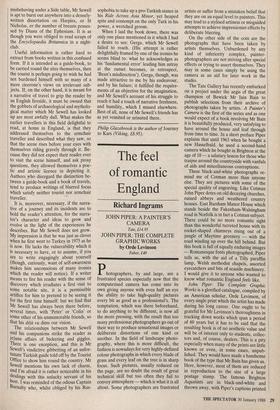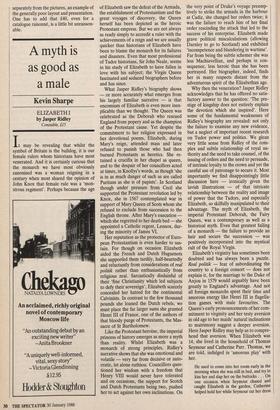The feel of romantic England
Richard Ingrams
JOHN PIPER: A PAINTER'S CAMERA
Tate, £14.95
JOHN PIPER: THE COMPLETE GRAPHIC WORKS by Orde Levinson
Faber, £40
Photographers, by and large, are a frustrated species especially now that the computerised camera has come into its own giving anyone with even half an eye the ability to take high-quality pictures every bit as good as a professional's. The temptation, which was there beforehand, to do anything to be different, is now all the more pressing, with the result that too many professional photographers go out of their way to produce sensational images or deliberate distortions of one kind or another. In the field of landscape photo- graphy, where this is more difficult, the fashion is nowadays for very highly-defined colour photographs in which every blade of grass and every leaf on the tree is in sharp focus. Such pictures, usually reduced on the page, are no doubt the result of great technical skill but too often they fail to convey atmosphere — which is what it is all about. Some photographers are frustrated artists or suffer from a mistaken belief that they are on an equal level to painters. This may lead to a stylised artiness or misguided attempts to achieve impressionist effects by deliberate blurring.
On the other side of the coin are the photographs that have been taken by artists themselves. Unburdened by any kind of inferiority complex, painter- photographers are not striving after special effects or trying to assert themselves. They May in some cases simply be using the camera as an aid for later work in the studio.
The Tate Gallery has recently embarked on a project under the aegis of the great champion of Bewick Mr lain Bain to publish selections from their archive of photographs taken by artists. A Painter's Camera is the first of the series and as one would expect of a book involving Mr Bain it is beautifully produced, very satisfying to have around the house and leaf through from time to time. In a short preface Piper explains that until 1963 when he bought a new Hasselbald, he used a second-hand camera which he bought in Brighton at the age of 18— a salutary lesson for those who traipse around the countryside with vanfuls of aids and miscellaneous contraptions.
These black-and-white photographs re- mind me of Cotman more than anyone else. They are pictures with some of the special quality of engraving. Like Cotman John Piper dotes on old decaying churches, ruined abbeys and weathered country houses. East Barsham Manor House which stands beside the Fakenham-Walsingham road in Norfolk is in fact a Cotman subject. There could be no more romantic sight than this wonderful turreted house with its rocket-shaped chimneys rising out of a jungle of Maytime greenery — with the road winding up over the hill behind. But this book is full of equally enduring images — Romanesque fonts photographed, Piper tells us, with the aid of a Tilly paraffin lamp, Welsh methodist chapels, assorted eyecatchers and bits of seaside machinery. I would give it to anyone who wanted to know what romantic England feels like.
John Piper: The Complete Graphic Works is a glorified catalogue, compiled by an American scholar, Orde Levinson, of every single print which the artist has made during his long career. One ought to be grateful for Mr Levinson's thoroughness in tracking down works which span a period of 60 years but it has to be said that the resulting book is of no aesthetic value and will be of interest only to students, collec- tors and, of course, dealers. This is a pity especially when many of the prints are little known or even, in some cases, unpub- lished. They would have made a handsome book of the type that Mr Bain has given us. Here, however, most of them are reduced in reproduction to the size of a large postage stamp. The famous Brighton Aquatints are in black-and-white and thrown away, with Piper's captions printed separately from the pictures, an example of the generally poor layout and presentation. One has to add that £40, even for a catalogue raisonne, is a little bit unraisson- able.



















































 Previous page
Previous page